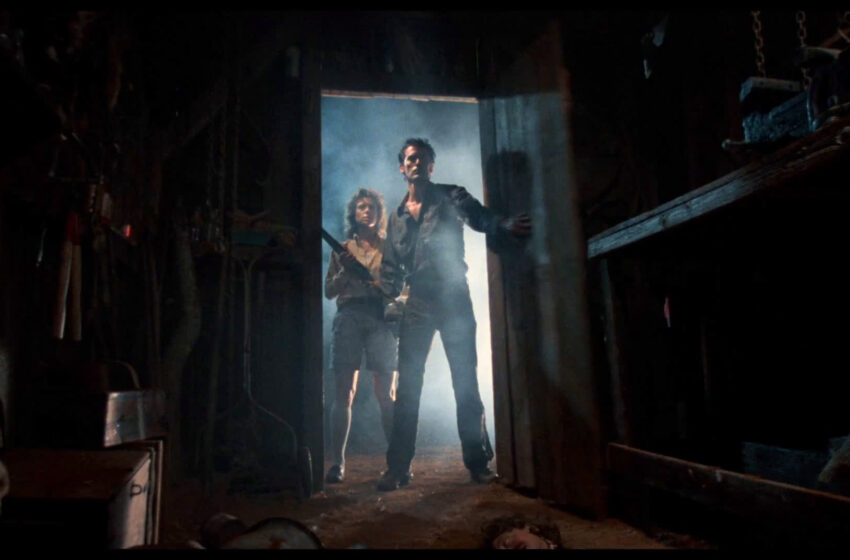
Evil Dead 2 (1987) – Film Review

Gather ‘round, seekers of cinematic sorcery, for an exploration through the delirious dimensions of a film so over-the-top, so wonderfully chaotic, and so gushingly grotesque that it defies the boundaries of conventional horror! Evil Dead II, the reimagining, or rather, the resplendidizing of its precariously low-budget predecessor, emerges from the depths of demonic darkness not just with blood and guts, but also with a rollicking rollercoaster of riotous humor and imaginative storytelling that etches an indelible mark upon the stone tablets of horror movie history.
When it comes to direction, Sam Raimi doesn’t just knock on the door of creative cinematography; he unhinges the door, catapults it into the abyss, and welcomes us into a realm where the camera is not just an observer but a frenzied participant in the madness. From swooping forest chases to dizzying demonic POVs, the film employs an arsenal of innovative camera techniques, imbuing it with a kinetic energy that galvanizes the viewing experience, turning it into an adrenaline-pumping spectacle.
Every frame, every scene, every moment is infused with a kind of frenzied innovation that sends the audience on a roller coaster ride through the delightful and demented depths of horror and humor.
One of Raimi’s hallmark techniques is his dynamic use of the camera. The camera in “Evil Dead II” is not a mere passive observer; it is an active, almost sentient participant in the narrative. It zooms, it swoops, it dives—it brings an energetic, almost chaotic personality to the film. It creates a sense of urgency, momentum, and unpredictability. The infamous “Raimi cam” sequences, where the camera moves rapidly through the woods, exemplify this kinetic style, establishing a first-person perspective of unseen demonic forces and intensifying the film’s immersive horror experience.
Raimi’s direction also excels in framing and visual composition. He uses exaggerated angles, stark contrasts, and inventive framing to enhance the unsettling and grotesque atmosphere of the film. His compositions are often asymmetrical, off-kilter, or exaggerated to create visual dissonance that echoes the film’s thematic chaos and madness.
His playful approach to genre conventions further defines his style. Raimi openly flirts with the boundaries of horror and comedy, blending gruesome terror with slapstick humor. His direction encourages over-the-top performances, animated expressions, and theatrical physicality from the actors, particularly Bruce Campbell, who delivers a legendary performance as Ash Williams. Raimi’s embrace of absurdity and melodrama crafts a unique and irresistible tone that defines “Evil Dead II” as a masterful exercise in horror-comedy.
Moreover, his inventive use of practical effects and in-camera tricks exemplifies a resourceful and creative directorial approach. He maximizes the potential of makeup, prosthetics, stop-motion animation, and mechanical effects to create the film’s grotesque visuals and horrific creatures. This commitment to practical effects enhances the tangible, visceral quality of the horror, making the unreal feel disturbingly real.
Now, delve deeper into the chambers of this visual spectacle, and you’ll stumble upon the film’s lead and horror icon—Bruce Campbell. His portrayal of Ash Williams is a masterclass in physical comedy and emotive expressions, manifesting a character who is as charismatic as he is chainsaw-handed. Campbell’s face, a canvas upon which is painted the broad strokes of terror, bewilderment, and manic determination, becomes an essential element in conveying the film’s mood, often oscillating between grim horror and slapstick hilarity.
Tucked away behind the cobwebbed curtains of this horror house are the nuggets of behind-the-scenes alchemy that transformed mundane materials into the lush landscapes of loathsome loveliness that adorn the film. The makeup and special effects, crafted with both ingenuity and a clear love for the grotesque, breathe life into the undead inhabitants of this nightmarish narrative. The wizards behind these effects wielded their brushes and prosthetics with the precision of surgeons, and the creativity of mad scientists, giving birth to scenes that linger in the minds of viewers, like adoringly grotesque afterthoughts.
Navigating through the narrative, we find the delightful decision to sprinkle the horrifying happenings with a generous helping of humor. The movie doesn’t merely walk the tightrope between horror and comedy; it dances upon it, juggling chainsaws of chilling terror and rubber chickens of ridiculousness with a deft agility that ensures neither element overstays its welcome. This delicate balance crafts a unique ambiance, where laughter may be abruptly severed by screams, and where moments of terror are softened with the cushion of campy humor.
Unveiling further layers, we discern the movie’s glorious embrace of practical effects—a symphony of splattering symphonics where blood flows with the gusto of a geyser, and heads roll with the enthusiasm of bowling balls. This choice doesn’t merely serve the aesthetics of the era but amplifies the tactile terror that pervades the film, allowing the audience to revel in the riotous ballet of believable body horrors. The ingenuity didn’t just stop at the grotesque and grim; no dear readers, it bled into the realms of reality, using low-budget creativity, from employing the director’s own car to various DIY steadicams and riggings that were as innovative as they were effective.
And as our journey through this demon-infested domain nears its temporary pause—because who can ever truly depart from the delightful madness of Evil Dead II—let’s pay homage to the film’s ability to reimagine and revitalize itself. Evil Dead II stands not merely as a sequel but as a cinematic phoenix, resurrecting from the ashes of its predecessor with bolder feathers, a more resounding screech, and a wild, unapologetic embrace of the marvelous mayhem of movie magic.
In this magnificent mural of the macabre, where every frame pulsates with passion and creativity, where conventions are contorted, and where the unexpected is the ultimate overlord, Evil Dead II stands tall—a beautiful behemoth of bedlam, an unyielding umpire in the unpredictable game of horror innovation and imagination.




